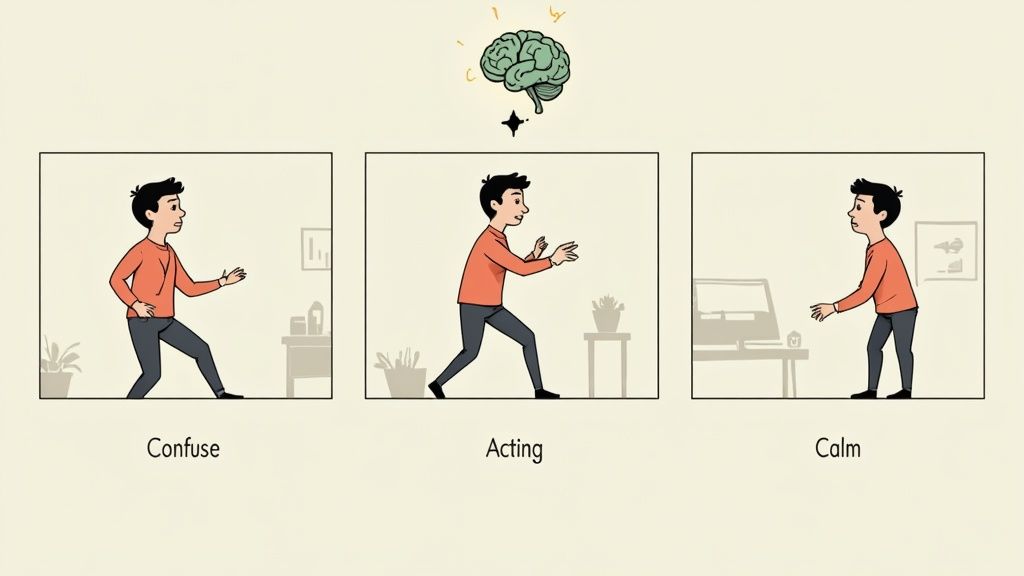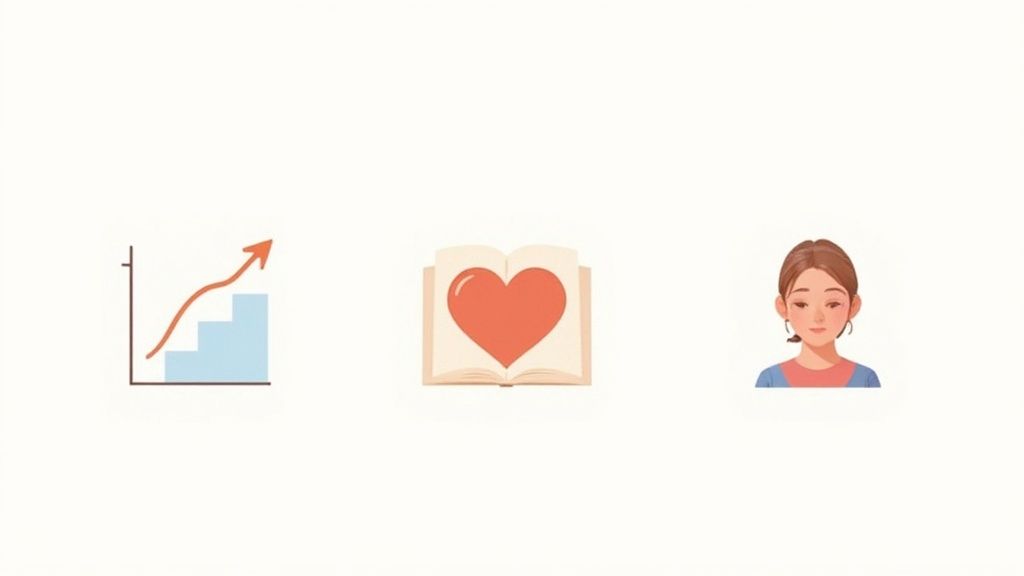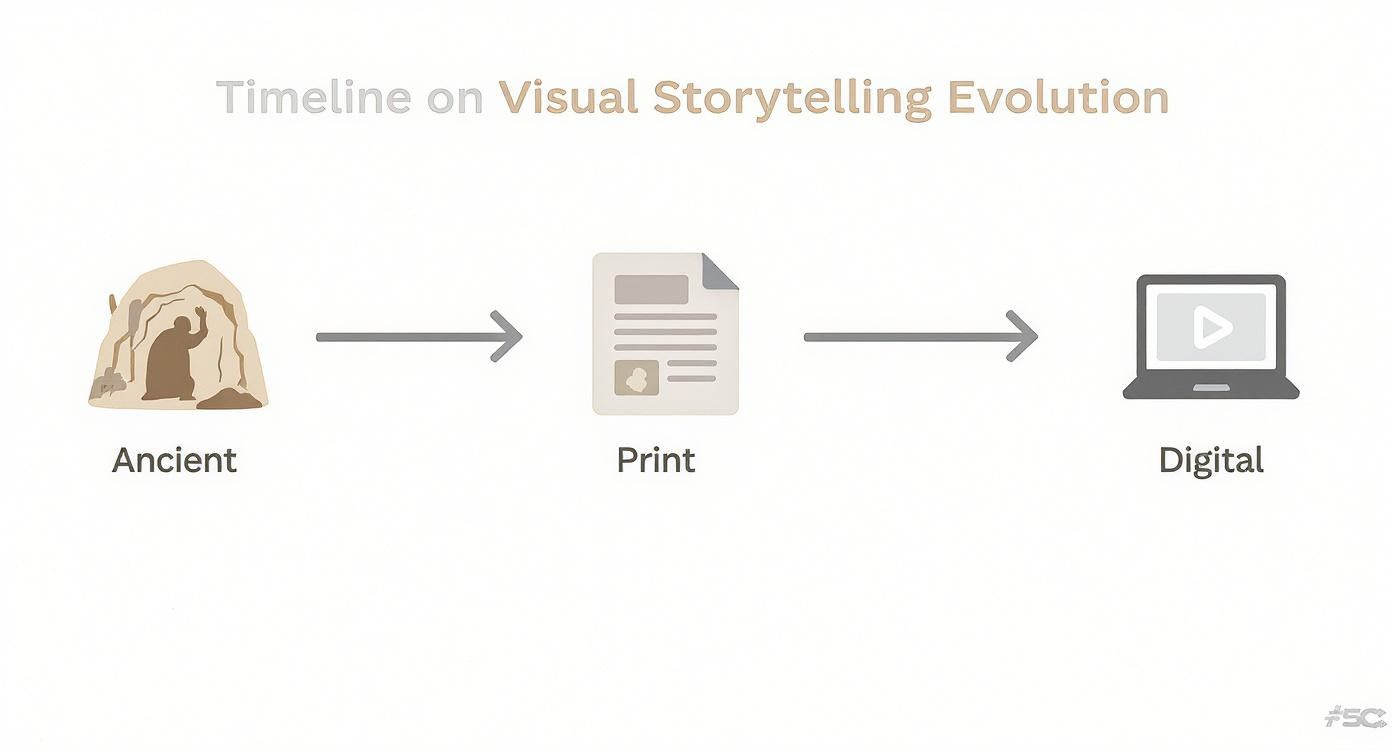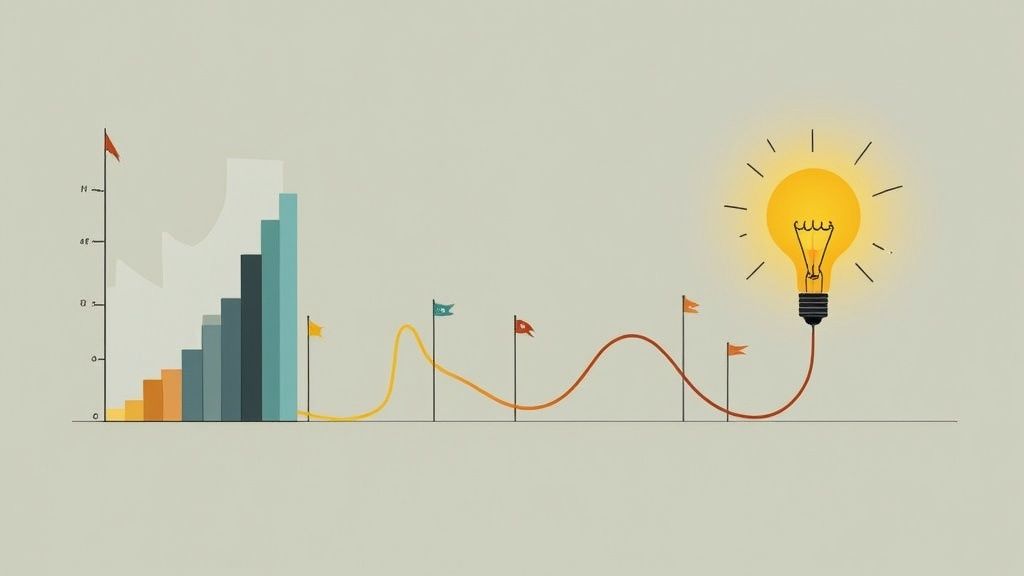what is visual storytelling: Quick Guide to Engaging Content
what is visual storytelling: Quick Guide to Engaging Content
At its core, visual storytelling is the art of weaving a narrative using images, videos, and graphics. It's more than just making things look good; it's about strategically arranging visual elements to take your audience on a journey.
Think of it as telling a complete story—with a beginning, middle, and end—but using pictures instead of words.
What Is Visual Storytelling Exactly?

Imagine watching an old silent film. There's no dialogue, yet you follow the plot, connect with the characters, and feel every bit of the drama. The entire story unfolds through a deliberate sequence of visual cues: a character's expression, a specific action, or the way a scene is framed. That’s the essence of visual storytelling.
It’s not just about snapping a pretty photo or designing a cool graphic. It’s about how you arrange those pieces to guide someone's understanding. Each image or video clip is like a sentence, building on the one before it to create a cohesive and engaging story.
Why Visuals Speak Louder Than Words
Our brains are hardwired for visuals. In fact, we process images a staggering 60,000 times faster than text. This isn't just a fun fact; it's a fundamental aspect of human perception. It means that showing an idea has a far more immediate and lasting impact than simply describing it.
This built-in biological shortcut is what makes visual narratives so incredibly powerful. Instead of asking your audience to read and mentally assemble a concept, you're handing them a story their brain can decode almost instantly. In a world overflowing with information, that efficiency is everything.
A well-crafted visual story bypasses the analytical part of the brain and speaks directly to its emotional center, making the message more memorable and persuasive.
The Power of Narrative in Marketing
Ultimately, visual storytelling is about connection. It's how brands and creators stop sounding like faceless entities and start feeling human. It can turn dry data or a vague mission statement into something tangible and relatable.
To really grasp its impact, it's worth exploring the power of storytelling in marketing and how narratives shape our perceptions. When you wrap your message in a story, you’re no longer just selling a product. You’re sharing a vision and building an emotional bond that turns customers into loyal followers.
The Core Principles of a Compelling Visual Story

What’s the real difference between a random photo dump and a visual story that actually sticks with you? It comes down to a few core principles that give your visuals a purpose and a soul.
Think of these principles as the essential ingredients. When you combine them correctly, you’re not just showing your audience something—you’re making them feel it.
Weaving a Clear Narrative Arc
Every great story, visual or otherwise, has a backbone. That's the narrative arc. It’s the simple, timeless structure of a beginning, a middle, and an end that gives your visuals momentum and meaning. Without it, you just have pictures. With it, you have a journey.
Imagine a nonprofit telling its story. They could start with a photo showing a community facing a challenge (the beginning), then show images of volunteers and locals working together to build something new (the rising action), and finish with a shot of the successful, thriving project (the resolution). This structure turns static images into a powerful, easy-to-follow narrative. For more ideas on how this works in practice, check out these brand narrative examples.
A strong narrative arc doesn't just present visuals; it arranges them to create a sense of momentum and emotional investment, making the final message far more impactful.
Achieving Emotional Resonance
Facts inform, but feelings persuade. The best visual stories do more than just present information; they tap into human emotion. This emotional resonance is what forges a genuine connection with your audience.
You can steer these feelings through deliberate choices. Color, lighting, and composition are your best friends here. A warm, sun-drenched photo can feel hopeful and joyful, while muted, cool tones might suggest melancholy or seriousness. A tight, close-up shot of a face feels intimate and personal; a wide, distant shot can create a sense of scale or even isolation. These aren't just technical details—they are your tools for creating a mood.
Committing to Authenticity
People can smell a fake a mile away, especially online. Authenticity isn’t a buzzword; it’s a requirement for building trust. Your story needs to be grounded in something real, whether that’s genuine moments, real people, or believable scenarios.
When you show something, your audience needs to believe it. This is why it’s so critical to use genuine imagery and avoid anything that feels staged or overly polished. In fact, knowing how to check if a photo is real has become a crucial skill. When your visuals are authentic, your message becomes credible.
A Quick History of Telling Stories with Pictures
It’s easy to think of visual storytelling as a new thing, born from Instagram feeds and TikTok videos. But really, it's one of the oldest human traditions we have. Before we ever wrote a single word, we were drawing our stories for everyone to see.
Think about the earliest cave paintings. Those weren't just decorations. They were practical guides, a way to teach the next generation how to hunt or to remember a major event. It was history, instruction, and art all rolled into one. The tools have certainly gotten more advanced, but the core idea of sharing an experience through images has been with us from the very beginning.
From Cave Walls to Clicks
The history of visual storytelling is really the history of human communication. Every time a new technology came along, our ability to tell visual stories took a giant leap forward.
- Ancient Art: For thousands of years, stories were etched into rock as petroglyphs or painted onto walls with charcoal and pigment.
- The Printing Press: Suddenly, with paper and printing, we could mass-produce stories. Books began to feature detailed woodcut illustrations and engravings alongside the text, bringing narratives to life for a much wider audience.
- The Digital Age: Now, the internet lets us create experiences that are truly immersive. We can weave together photos, videos, text, and even interactive charts into a single, compelling story.
The tools may have evolved from a piece of charcoal to a piece of code, but our deep-seated need to show our stories, not just tell them, hasn't changed one bit.
In the modern era, a real turning point was The New York Times' groundbreaking 2012 piece, "Snow Fall." It masterfully blended video, animation, and text to pull readers into the harrowing story of a group of trapped skiers. It wasn't just an article; it was an experience. This project showed everyone what was possible online and set a new benchmark for digital narratives. If you want to dive deeper, there's a great piece on the rich history of visual storytelling and its key milestones.
Choosing the Right Format for Your Visual Story
The medium you choose to tell your story is just as crucial as the narrative itself. Selecting the right format is the difference between your message landing perfectly or falling flat. It’s all about making sure your story not only reaches your audience but truly connects with them.
After all, you wouldn't try to explain a complex financial report with a short, punchy social media video. And a deeply emotional story would lose its soul if it were crammed into a static data chart. The key is matching the purpose of your story to the strengths of its format.
The infographic below traces the incredible evolution of visual storytelling, from ancient cave paintings right up to the digital media we use today.

This journey shows that while our tools have changed dramatically, our fundamental need to share experiences through images is as old as humanity itself.
Common Visual Storytelling Formats
So, how do you pick the right one? Let's break down some of the most powerful formats available today and look at where each one shines.
Infographics: These are your go-to for making complex data easy to understand and even easier to share. Use them to break down stats, explain a step-by-step process, or compare different options. They turn a wall of text into something engaging and scannable.
Video: Nothing beats video when you need to create a dynamic, emotional narrative. It's the perfect medium for combining moving images, sound, and text to build suspense, show a product in action, or forge a real human connection through a powerful testimonial.
Photo Essays: Think of these as documentary-style stories told through a carefully selected series of still images. A photo essay is fantastic for capturing authentic moments, showing a journey from start to finish, or giving a behind-the-scenes look that builds trust and credibility.
Choosing Your Medium
Ultimately, the right format depends on your goals and your audience. An immersive, interactive web experience could be perfect for a major brand launch, while a simple, impactful social media story is better suited for daily engagement.
The most effective visual stories don't just happen; they are thoughtfully designed. The format is the stage, and the visuals are the actors—both must work together to bring the narrative to life.
For example, something as simple as the colors you use can completely change the mood of your story. Understanding color psychology in branding helps you pick a palette that reinforces the emotional tone, no matter which format you’re using.
The best format is always the one that delivers your core message clearly and memorably, turning passive viewers into an engaged audience.
How to Turn Data Into a Compelling Narrative

In a world obsessed with metrics, it's easy to get lost in the numbers. Spreadsheets and raw statistics rarely capture anyone's attention, much less persuade them. The real skill—the thing that sets great communicators apart—is the ability to transform that data into a story that actually means something.
This is where data visualization becomes a cornerstone of visual storytelling. It’s not about just making pretty charts. It’s about taking those charts and graphs and using them to reveal the plot hidden within the numbers—the unexpected trends, the critical turning points, and the real-world impact.
A thoughtfully designed visual doesn't just display figures; it builds a compelling case and leads your audience to an unavoidable conclusion.
Finding the Story in Your Data
Believe it or not, every dataset has a narrative just waiting to be discovered. The trick is to look past the digits and find the human element behind them. For instance, a sudden spike in sales isn't just a point on a line graph; it’s the climax of a successful campaign or the result of a fascinating shift in customer behavior.
To start digging for that story, ask yourself a few key questions:
- What changed? Pinpoint any dramatic increases, sharp drops, or surprising shifts in the pattern.
- What stands out? Look for the outliers—the numbers that defy expectations and hint at a new opportunity.
- What's the real impact? Draw a clear line from the data to a tangible outcome or a human experience.
The goal is to translate abstract figures into a concrete, persuasive narrative that is clear, engaging, and drives decision-making.
This isn’t just a neat trick; it’s becoming standard practice. A recent survey revealed that 53.5% of professionals now rely on data visualization tools for their storytelling. With the market for this technology expected to hit $16.54 billion by 2029, it's safe to say that turning data into a story is a core business skill. You can discover more about these visual storytelling statistics and see just how big this is getting.
When you focus on the narrative, you make your data memorable. It also ensures you’re tracking the right content marketing metrics to build a truly powerful story.
Still Have Questions About Visual Storytelling?
Even when you get the basic idea, putting visual storytelling into practice can feel a bit fuzzy. It’s normal to wonder where the line is between good design and a good story, or if this is something only big-shot companies can afford.
Let's tackle some of the most common questions that pop up. Clearing the air on these points will help you move from theory to action with more confidence.
Design Versus Storytelling
So, what's the real difference between visual design and visual storytelling? They're definitely related, but they're playing different games. Visual design is all about the "how"—the layout, colors, and fonts that make something look great and work well. It’s focused on aesthetics and function.
Visual storytelling, on the other hand, is about the "why." It takes all those design principles and puts them to work to tell a story. Think of it this way: a designer might build a beautiful website, but a visual storyteller designs that website to walk a visitor through a specific emotional journey. The secret ingredient is the narrative arc.
Can Small Businesses Use Visual Storytelling?
One hundred percent, yes. You don't need a Hollywood budget to tell a powerful visual story. In fact, small businesses have an advantage: authenticity. Your smartphone is more than enough to capture real behind-the-scenes moments or customer stories for social media.
Tools like Canva make it easy for anyone to whip up a simple infographic or a branded graphic that shares a piece of your company's heart.
Remember, authenticity and consistency beat a big budget every time. A genuine story told with simple visuals will connect with people far more deeply than a slick but soulless production.
This is how you build a relatable personality that giant corporations can only dream of.
How to Measure Success
Okay, but how do you know if it's actually working? Measuring success isn't about one magic number; it’s about tying your results back to your original goals.
What you track depends entirely on what you wanted to achieve.
- Looking for Engagement? Keep an eye on likes, shares, comments, and how long people stick around on your page.
- Need More Conversions? Measure click-through rates, how many leads you generated, or sales that came directly from your visual content.
- Trying to Build Brand Awareness? Monitor your reach, follower growth, and how often people are talking about you online.
The best approach is to blend the hard numbers (quantitative data) with the human feedback (qualitative stuff like comments). That’ll give you the full picture of your story’s impact.
Where Should You Begin?
What’s the absolute first step? Before you even think about cameras or design software, you need to nail down your core message and your audience.
Just ask yourself two simple questions:
- If my audience remembers only one thing from this, what should it be?
- Who, exactly, is this story for?
Your answers are your North Star. They'll guide every single choice you make, from the visual style to the platform you post on. Without that clarity, you just have a bunch of pretty pictures with no purpose.
Ready to create a month's worth of on-brand social media content in minutes? Outbrand uses AI to generate a complete content calendar with visuals, captions, and posts tailored to your brand voice and goals. Stop brainstorming and start building your brand today. Find your plan at Outbrand.
Related Articles
Top Marketing Content Ideas to Boost Your Strategy
Explore innovative marketing content ideas to enhance your strategy. Find fresh tips, examples, and ways to engage your audience effectively.
Mastering the Art of Developing Marketing Personas
A practical guide to developing marketing personas that drive real business growth. Learn to gather data, build profiles, and embed them in your strategy.
Social Media Marketing Plan Template: Create Your Strategy
Use our social media marketing plan template to build, implement, and measure your strategy for real business growth. Get started today!
Ready to Create a Month of Content?
Stop spending hours writing social media posts. Let AI create 30 days of engaging content tailored to your brand in minutes.